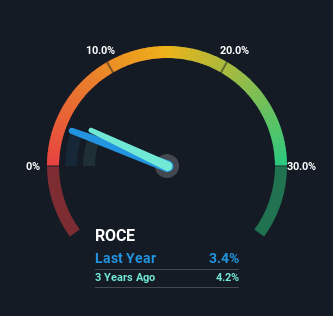- China
- /
- Semiconductors
- /
- SHSE:688432
Be Wary Of GRINM Semiconductor Materials (SHSE:688432) And Its Returns On Capital
If we want to find a stock that could multiply over the long term, what are the underlying trends we should look for? Firstly, we'll want to see a proven return on capital employed (ROCE) that is increasing, and secondly, an expanding base of capital employed. If you see this, it typically means it's a company with a great business model and plenty of profitable reinvestment opportunities. However, after briefly looking over the numbers, we don't think GRINM Semiconductor Materials (SHSE:688432) has the makings of a multi-bagger going forward, but let's have a look at why that may be.
Understanding Return On Capital Employed (ROCE)
For those who don't know, ROCE is a measure of a company's yearly pre-tax profit (its return), relative to the capital employed in the business. The formula for this calculation on GRINM Semiconductor Materials is:
Return on Capital Employed = Earnings Before Interest and Tax (EBIT) ÷ (Total Assets - Current Liabilities)
0.034 = CN¥163m ÷ (CN¥5.0b - CN¥205m) (Based on the trailing twelve months to March 2024).
Thus, GRINM Semiconductor Materials has an ROCE of 3.4%. On its own, that's a low figure but it's around the 3.9% average generated by the Semiconductor industry.
Check out our latest analysis for GRINM Semiconductor Materials

In the above chart we have measured GRINM Semiconductor Materials' prior ROCE against its prior performance, but the future is arguably more important. If you'd like, you can check out the forecasts from the analysts covering GRINM Semiconductor Materials for free.
The Trend Of ROCE
In terms of GRINM Semiconductor Materials' historical ROCE movements, the trend isn't fantastic. Around five years ago the returns on capital were 17%, but since then they've fallen to 3.4%. Given the business is employing more capital while revenue has slipped, this is a bit concerning. If this were to continue, you might be looking at a company that is trying to reinvest for growth but is actually losing market share since sales haven't increased.
On a side note, GRINM Semiconductor Materials has done well to pay down its current liabilities to 4.1% of total assets. That could partly explain why the ROCE has dropped. Effectively this means their suppliers or short-term creditors are funding less of the business, which reduces some elements of risk. Some would claim this reduces the business' efficiency at generating ROCE since it is now funding more of the operations with its own money.
What We Can Learn From GRINM Semiconductor Materials' ROCE
From the above analysis, we find it rather worrisome that returns on capital and sales for GRINM Semiconductor Materials have fallen, meanwhile the business is employing more capital than it was five years ago. Long term shareholders who've owned the stock over the last year have experienced a 39% depreciation in their investment, so it appears the market might not like these trends either. Unless there is a shift to a more positive trajectory in these metrics, we would look elsewhere.
One more thing, we've spotted 2 warning signs facing GRINM Semiconductor Materials that you might find interesting.
While GRINM Semiconductor Materials may not currently earn the highest returns, we've compiled a list of companies that currently earn more than 25% return on equity. Check out this free list here.
New: Manage All Your Stock Portfolios in One Place
We've created the ultimate portfolio companion for stock investors, and it's free.
• Connect an unlimited number of Portfolios and see your total in one currency
• Be alerted to new Warning Signs or Risks via email or mobile
• Track the Fair Value of your stocks
Have feedback on this article? Concerned about the content? Get in touch with us directly. Alternatively, email editorial-team (at) simplywallst.com.
This article by Simply Wall St is general in nature. We provide commentary based on historical data and analyst forecasts only using an unbiased methodology and our articles are not intended to be financial advice. It does not constitute a recommendation to buy or sell any stock, and does not take account of your objectives, or your financial situation. We aim to bring you long-term focused analysis driven by fundamental data. Note that our analysis may not factor in the latest price-sensitive company announcements or qualitative material. Simply Wall St has no position in any stocks mentioned.
About SHSE:688432
GRINM Semiconductor Materials
Engages in the research, development, production, and operation of silicon and other semiconductor materials and equipment in China.
Flawless balance sheet with moderate growth potential.
Market Insights
Community Narratives



